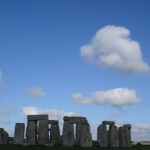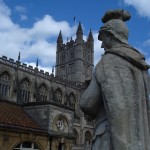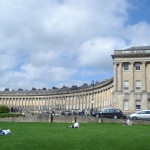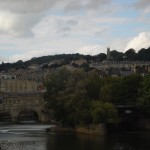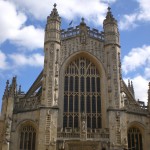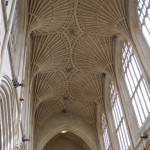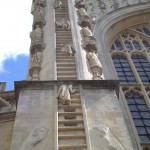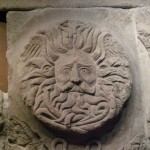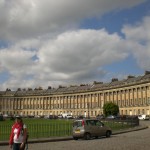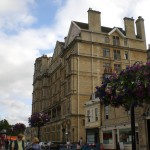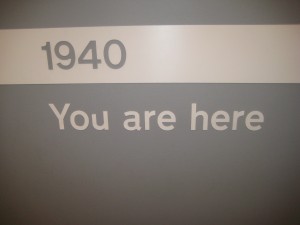
As I entered The Cabinet War Rooms and Churchill Museum I noticed a sign that appropriately read “1940 – You are here.” The War Rooms especially had the effect of transporting me back through the decades and directly into the blitz years. I let myself become immersed in the time period, trying to experience the War Rooms as they would have been experienced during the blitz. Walking through the halls and listening to the recordings of secretaries furiously punching at typewriters, phones ringing, air raid sirens screaming and the distant, guttural peal of bombs – like some Gregorian chant – , I felt as though I truly was there.
Living quarters were by no means spacious or luxurious. Winston Churchill and his staff lived in small bedrooms with small twin beds – some cots, even – and small furniture, and they cooked in a small kitchen. The fact that the Prime Minister lived and worked in a somewhat average space – though his accommodations were by no means completely Spartan – impressed me. It reminded me of how The Queen Mother rejoiced at the bombing of Buckingham palace and felt that she could now more closely connect and identify with her subjects. Churchill, in this way, was living in a similar fashion as those who elected him.
The War Rooms themselves were built underground. It consisted of several levels including a sub-basement or crawl space area. The Rooms were protected by steel-reinforced concrete up to three metres thick, depending on the area. The halls seemed labyrinthine – I’m not sure if the Rooms were laid out this way throughout the blitz, or if they were re-arranged when the museum was opened, though many of the rooms were left just as they were.
The Churchill museum was equally as interesting, though it brought up current issues as well as those from the past. One section in particular focused on Churchill’s sentiments towards the Indians. In rather “politically correct” and certainly “British” words, a placard mentioned that Churchill took a social Darwinist approach with his policies towards India, claiming that if Great Britain had not intervened, the religious factions in the country would surely turn against one another in a barbaric warfare. I was not particularly surprised by this, unfortunately, considering the problems dealing with race and ethnicity seen so frequently throughout the latter half of the 20th century. In fact, perhaps those later problems were actually rooted within the racist history of previous British policy.
Overall, the museum was very informative and interesting, especially the Cabinet War Rooms section. The ability of the exhibit to situate the visitor in the heat of the blitz renders this museum truly successful in meeting the goal that all museums should strive to achieve;reaching – and truly affecting – its audience.
Tags: Anya · Museums
While going through the British Museum, the National Gallery and the Tate Modern I noticed the lack of British art and artifacts represented throughout these museums. I learned in my Museum Studies class that even major museums in America there are this lack of American artwork in them. Of course this is mainly because America is such a young country and we are beginning to establish our place in the art world just like other older countries have done. Even so, why is Great Britain still under represented, even within their own country?
I began to observe in every major museum in London that I’ve visited to so far this lack of British art. At the National Gallery there were only a few rooms (about 3) dedicated to the country’s artists. For being the “National Gallery” it seemed to be dominated quite a lot by Italian and French artwork. By viewing the layout of the gallery, it is easy to notice the complete lack of British art. It is also noticeable that it is not even the focal point of the museum, but the rooms displaying the artwork are pushed off to the side.
The British Museum also did not live up to its name. Great Britain only had about 4 parts of the entire “British” Museum showing British artifacts, mostly from the Medieval and Roman time periods. The majority of the museum displayed their stolen “acquisitions” from other parts of the world. And still even in this museum Great Britain was not the focal point in the least, for what is one of the first places you see when you walk in but the stolen Egyptian artifacts.
The Tate Modern also did not display many British artists. The gallery seemed to be dominated by American, French and all other countries other than Great Britain. Even America had a much larger place in this museum because of their prominence and prestige amongst the modern and post-modern art world. If you do a quick browse of this museum’s layout, it is easy to see hardly any British artists.
Why I believe there is a general lack of British art and artifacts is because most museums in a large city are meant to show off the prominence and power of that country. In the British Museum, Britain is still shown as a world power and it proudly displays the “booty” they have collected from their conquests of these other countries. Even in the new modern and post-modern art museum, the Tate, these same ideas still play through, just less pronounced than the other two. Museums are still viewed, even in the 21st century, as places of national pride and places to show off your conquests and the “treasures” to the rest of the world.
Tags: Alli · Museums
August 29th, 2009 · 1 Comment
Today we wandered, via the scenic route, over to the Victoria and Albert Museum in South Kensington. We knew that it would be an eclectic and eccentric collection, but we were in for a surprise…
Upon exiting the convient tunnel linking the Tube to several well-visited museums and sites in the area, we found ourselves in a ground floor sculpture hall. Randomly picking a direction to walk in, we wandered into in the fashion section. (Aidan and Brandon were thrilled.) In this collection we found everything from hautecouture to Elizabethan-era ensembles. Some of these clothes were truly shocking! One such item reminded Kelley of a woolly mammoth, but alas, it was a apres ski jacket. While we were lingering by a shirt made from a parachute and some heavily-sequined items, we could see into an exhibit of Raphael’s cartoons.

The Woolly Mammoth, erm, Apres Ski Jacket (picture taken from the website of the Victoria and Albert Museum)
A cartoon is a preliminary drawing for either a tapestry or a painting. In this case, the drawings were for a series of tapestries commissioned for Pope Leo X and they depicted a number of scenes from the Bible. We were impressed with the sheer size and careful preservation of the drawings. As one of the completed tapestries was present, it was also interesting to see what the finished product looked like.
We decided simply to wander from exhibit to exhibit in order to understand the Victoria and Albert collection as a whole. We were met with limited success. While the museum contains an extensive array of artifacts from around the globe, we found that there was no logical flow pattern in the museum. For example, we went from Korea to the European Cast Court (essentially a large number of copies of well-known facades and memorials) and again from finely-painted late 19th century tables to the radios of the 20th century. Essentially, we were confused. Why were these objects here and what is the purpose of their order? What is the collection of the Victoria and Albert trying to say to the visitor? It reminded Grace of a really nice yard sale. To Kelley, it was like searching around her grandparent’s basement. We found the artifacts to be very interesting and laid out well within their exhibits,we just question the museum’s purpose as a whole. That said, it was a worthwhile way to spend an afternoon. (We highly recommend going out into the garden and watching the children playing in the paddling pool!)
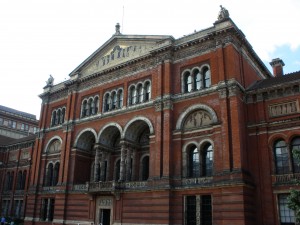
The architecture of the V&A from the garden
Tags: Grace · Kelley · Museums · Uncategorized
August 29th, 2009 · 1 Comment
Last Thursday morning at 8 a.m. both the Humanities and Science programs piled on a bus and began our first journey outside of London since arriving almost exactly a week before. Our first stop on the journey was Stonehenge. Going into it I had mixed feelings about this collection of rocks. From what I had seen on television and from what I had read about Stonehenge they seemed so mysterious and fascinating. I guess I was worried that actually going to Stonehenge would somehow sour their mystique to me. I didn’t want something that I had always considered so majestic to all of a sudden lose its aura of greatness. In addition I had been told by friends who had been on the Norwich Humanities program before that Stonehenge did not meet their expectations.
After about a two hour bus ride we pulled off a highway and at the top of a hill we saw our destination in the middle of a field. Upon arrival Aidan and I joked about the famous scene in “This Is Spinal Tap” where the band accidentally receives miniature Stonehenge models for their rock concert that are about half the size of dwarves that are dancing a jig around them. Once I received my electronic tour device I headed up to the top of the hill where I proceeded to take a multitude of pictures from all angles and vantage points. The tour device was helpful and helped me understand the figure as more than just a pile of rocks. Overall I was not disappointed by Stonehenge and it did not lose its mystique for me but I was glad that we only spent an hour at the site. There really isn’t much to do there once you’ve listened to the tour and used up every picture angle possible.
The next stop on our trip was Bath. Unlike Stonehenge I had heard only positive things about this part of the journey so I went in with fairly high expectations. At the end of the day my expectations were more than satisfied. The ride from Stonehenge to Bath took us through some beautiful English countryside. We passed some classic country houses and weaved in and out of lush valleys the whole journey. While listening to “Stairway to Heaven” on the bus ride over I attempted to envision Robert Plant and Jimmy Page sitting in the countryside right outside my window, strumming guitars and trying to come up with lyrics for their ’71 masterpiece. As we approached Bath I was immediately impressed by the architecture I observed in the distance. Many of the houses sat on top of a hill separated by a river. A truly remarkable sight.
Once we arrived a bunch of us headed off to find a place to eat lunch. We decided on a half pub/diner type of restaurant where I ordered the Pie of the Day. Overall the food was mediocre for its price. I’m still having a little trouble distinguishing which restaurants appeal to me and which don’t. When in doubt the Fish and Chips in any pub is usually a great choice for me. After lunch we headed to Bath Abbey before our class trip to the Roman Baths. Bath Abbey was gorgeous. Not quite as remarkable or as massive as Westminster but definitely in the same ballpark. Already sensing that the town of Bath would be a place to remember I bought a few postcards in the gift shop and headed over to the baths.
Overall seeing the baths was a great experience. It is amazing and a little disconcerting to me to think that hundreds of years ago a multitude of men bathed in the very same spot that we were walking around in casually and taking pictures. The columns and statues of Romans surrounding the large bath were beautifully done. The water was an odd colour of green so for anyone that would have been tempted to touch it despite the guides warning, this became the final deterrent. I spent about an hour in the Baths before heading up to the Royal Crescent where I would spend the first part of my afternoon. Once I got my fill of the beautiful Georgian Architecture that makes up the crescent I headed over to the park across the street where a bunch of us layed down for about an hour just talking and relaxing.
After a quick coffee break Kelley, Grace and I decided to take a walk around the nearby river. This was easily my favorite part of the trip. The view up the river looking into the town was incredibly picturesque. On this walk I got a sense of the true/non-touristy feel of Bath. There were parks, small trinket shops along the river and even a rugby pitch. Maybe most tourists just don’t have the time for it during their excursions to Bath but the path along the river was wonderful and I would head back there in a heartbeat to explore more of the area.
Overall my trip to Bath helped me conclude a number of things. The first is that, as much as I love being in London, I definitely prefer a smaller town atmosphere a little out of the way. The second thing this trip confirmed is that the English Countryside is just as beautiful as people have told me. Despite my need for sleep on the 2 hour bus ride back to London I resisted because I enjoyed observing the landscape so much. If I have some time later in the year I would definitely return to Bath. There is still a lot to see.
Tags: Churches and Cathedrals · Henry
Let me preface all of this by saying that I am, as my fellow classmates have stated, incredibly grateful for the opportunity to see both Stonehedge and Bath– two great world heritage sites. Both trips were incredible and photograph-worthy (believe me, I took enough pictures for the entire year that day). I, however, do not share my classmates’ adoration of the city of Bath. I doubt a person exists in the world who doesn’t find the city to be one of beauty. That being said, a city built to cater to tourists is one that does not rank on my list of favorite places in the world. I recognize that I am a tourist so begrudging a city for catering to me sounds a bit odd. Truly though I would rather visit a place to appreciate what it has to offer rather than it intentionally enticing me to visit it by being built around what it thinks I might like.
At the Roman Baths themselves, I found myself most attracted to the Bill Bryson audio option on the audio tour. An author of many travel books, he was well-equipped to take me around the Roman Baths in an educational and still humorous manner. He made a comment at one of the corners that if you looked around you would see how much the site has been altered since the Romans bathed there. Following his advice, I looked around. I saw a water fountain out of which you could drink the very water that the Romans bathed in for a low, low price of fifty pence. I saw a newly remodeled bathroom that was made to look like an authentic Roman bathroom equipped with automatic sinks and hand driers. I saw outside of the baths street performers that were both incredibly talented and incredibly good at attracting large amounts of people. I then realized that I was listening to Bill Bryson. Let’s pause. Listening to him was a great way to get through the museum. But Bill Bryson? Such a recognizable name guarantees that the museum is authentic. Right? Maybe the museum was even it was being invaded by the idea of catering to the tourist while still trying to make a pound or two from the endeavor.
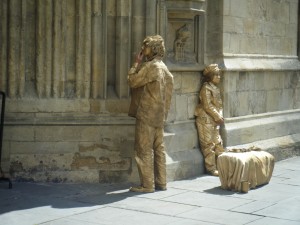
Street performers in Bath
Upon leaving the museum, a fellow student and I decided to try to capture the beauty of the city (because, truly, being built for tourists does have its perks when it comes to the overall visual beauty of the city). Deciding that the top of the hill would bring the best result for such a photo opportunity, we began our ascent. Two hours later, we realized that we were not the only one’s who thought the top of the hill was the best way to view the city. All of the residences were placed up there with beautiful views…and walls surrounding their homes to shield nosy tourists away from enjoying those views. The tourists, it seems, were to stay in the valley where they should be content to watch the street performers, shop around in cutesy boutiques, and listen to the soothing voice of Bill Bryson. I have nothing against such things! But it seems to me that if a tourist is willing to venture away from those confines and really get to know the place that is Bath, they should be able to. If a tourist wants to see and experience the landscape that the city sits upon, the true foundation of the city, they should be able to. It seems that those that profit from keeping the tourists down in the valley have other ideas. Our differences aside, the other student and I were able to get the shot (after two hours of searching). We had to climb up on a wall and duck under a few tree branches to get it, but we were successful nonetheless. When a woman who was walking her dog saw us, she rolled her eyes in a way that suggested she knew our kind all too well. “Tourists” she seemed to sigh. And as she continued to walk by, I was for once happy to have that label to hide behind as reason for my seemingly odd behavior.
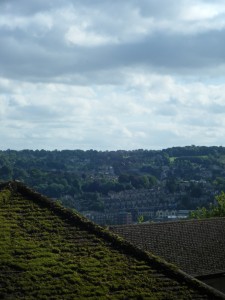
Only one of many picture taken from 'the view'
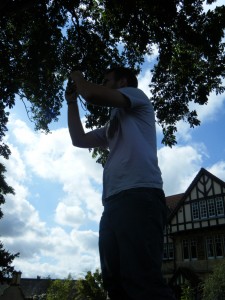
The dedication required to view Bath correctly
Just a side note: the following is a link to the criteria for a world heritage site. It’s just interesting to ponder in relation to what the city of Bath has become. List of criteria for World Heritage Sites
Tags: Audrey
I have to admit that I have not been to many plays in my life. As a matter of fact, the last play I remember attending was in middle school. If I recall correctly it was “Romeo and Juliet,” but I do not remember the performance at all. Fortunately, tonight we were able to see “Troilus and Cressida” in the Globe Theatre. At first, I was a bit apprehensive about standing for three hours and I am sure I wasn’t alone in that regard. Though that is what a “groundling” had to do and trying to recreate it makes The Globe historically accurate, I would have greatly appreciated a chair. Nevertheless, despite the lack of chairs and occasional rain, I thought the play was fantastic.
Every actor did a phenomenal job, the music was incredible and the props were well created. There were too many humorous scenes to mention, but overall the way in which the play was done was amazing. In particular, I thought the fight scenes were very well done. I also enjoyed the drums at the end, which was very unexpected. Perhaps because of all this, I did not realize at the end that three hours had passed. The entire performance was so mesmerizing that it just took me in.
Since I am so used to seeing entertainment through a screen, live acting was a treat. It seemed so much more authentic; the actors were right in front of you and they commanded your attention. I am excited to see more plays while in London and take this new passion back to the States.
Tags: Andrew F
I can honestly say that the day trip to Stonehenge and Bath was one of the best days of my life. First of all, the weather was fantastic and most of my great days start with great weather. Stonehenge was impressive, and I am truly thankful that we were able to visit, but I’m glad it was only allotted one hour of our time. I was really looking forward to the town of Bath, the home of an extremely well preserved Roman Bathhouse, beautiful Georgian architecture and yet another gorgeous Gothic Abbey. As our bus was winding up and around narrow country roads (and I was praying we didn’t run off them) the town came into view. My jaw dropped. In front of me was what appeared to be the quintessentially English country town…. Complete with Jane Austen! Lunch at the Rat and Parrot pub seemed like a good sign, I’ve never been called “dearie” and “love” more times in an hour than I was there. Walking through the bathhouse with my audio guide I learned about the history of the baths and the bathhouse culture of the Romans. While the museum commentary was informative, I ended up listening to Bill Bryson’s commentary rather than the museum. Bryson has a way of making the simplest truth hilarious. Perhaps it’s the way he phrases things, or maybe it’s the delivery. I still don’t know but I was laughing (and, of course learning) the whole time. The case dedicated to the ‘curses’ was especially hilarious. These little tablets were thrown into the waters as an offering to Minerva in hopes that she would grant what they wished. My favorite was the one about the missing cloak, in which the writer wishes all sorts of injury and ill luck upon the man who robbed him. How could this advanced society, this mighty empire, believe that inscribed tablets to the Gods would help them find their misplaces items? These little curses reminded me of Elementary school threats and superstitions… empty and irrational. “Step on a crack and you’ll break your mother’s back!” although, as a first grader it took me weeks to get over that one. The rest of the day was spent admiring the wonderful Georgian architecture and the Bath Abbey. Just as professor Qualls said, the fan-vaulted ceiling was incredible. The amount of detail that is used in a Gothic church always floors me. I don’t think I would have had the patience to complete it. Some of the most interesting elements were the climbing angel sculptures on the towers. I suppose they are meant to be climbing to heaven. I wanted to climb up there to see a better view of the whole town. I would go back to Bath in a heartbeat, anyone up for a weekend trip when we have time?
From one end of the spectrum to the other… the Tate Modern is the sister museum to the Tate Britain, which houses more ‘traditional’ art on the other side of the river. This old factory and warehouse has certainly retained its origins. The minute you walk in you are overpowered by the sheer space. It’s absolutely huge! Although now that I think about it, it is better to have all that empty space from the ground floor to the ceiling for a large instillation or sculpture. Because of time constraints, I was only able to explore one floor of exhibits. But within those two exhibits I was able to satisfy at small part of my quest to find Modern, British art. What do you think of when you think of British art? I always thought of Gainsboro’s portraits of upper class women in their taffeta gowns against a sweeping background of forest of meadows. Until yesterday I could count the number of British artists I had studied in a Dickinson art history class on my fingers. I was able to see some of my favorites in the abstract expressionism gallery. Kirchner and his take on the classic bathers motif (but with garish coloring and hash angles), Matisse and his simple yet powerful paper cutouts, and Lee Krasner’s Gothic Landscapes. When you research Lee Krasner after reading this, (I am sure most of you have never heard of her) please remember to view her art as a separate entity from her husband’s art…. She was a well-established artist in her own right before they were married. But back to the question, what does the art of a Modern Britain look like? I found a few answers in the Surrealism exhibit. Surrealism is fascinating to me. Not only does it explore the role of the subconscious and dreams, the art tends to pair opposite themes and emotions. Whimsy. Violence. Dark. Light. Primitive. Advanced. My first new artist was Roland Penrose. His piece, Portrait (1937) is a mix of words and images that pushed the boundaries of “acceptable” art out the window. Higher-ups who thought the word “arse” was too foul to use in art removed this piece from display. Little did they know that another one of his pieces used sign language to spell out the word “SHIT.” As I moved in to the Realism section I came into contact with several more new names. Margurite Kelsey, Stanley Spencer and Maraude Gueruarva all painted around 1930. The pieces in the Tate Modern all possess an element of mystery. Kelsey uses such fantastic lighting in her work and the style is almost academic, but at the same time thoroughly modern. Cornelia Parker’s instillation, Thirty Pieces of Silver (1988-9) was my favorite piece of the day. The artists had collected silver object, anything ranging form a teaspoon to a trombone and then had then all rolled over by a steamroller. Most of the items were flattened into wafer-thin version of their original shapes. She then arranged the new forms into disks suspended to the ceiling by thin wire. The effect is almost other-worldly. Looking across the room your eye gets lost in the maze of spider silk like threads sprouting from the ceiling. You follow the threads to the floor and “floating” directly above it– the silver disks. Not only are the disks themselves beautiful to look at, the shadows they cast creates an entirely separate work. I tried to look at the shadows and guess what the object above it was. Sometimes I could tell, other times, not so much. The only thing that could have made this instillation better would be the ability to walk all the way around it. At this time you are limited to two sides. Maybe this is how Parker imagined the instillation… Maybe I can try to find a suggestion box next time I am there.


So what is Modern British art? I don’t know that I have seen enough of a range to give you an answer. I can say that yesterday was an education and an experience. I hope to return to the Tate Modern when I have four or five free hours. I’ll call this the beginning of my quest. What do you think? My time here in London is flying by and each day leads me to see or try something new. I am so thankful for this opportunity.
Tags: Grace




